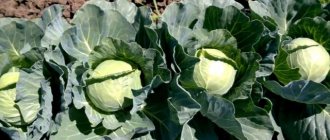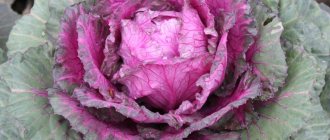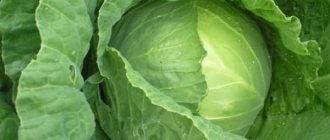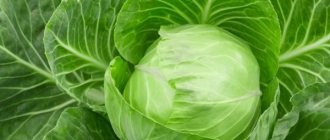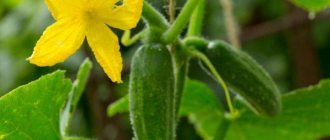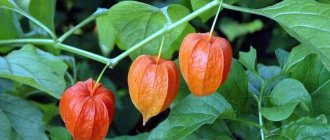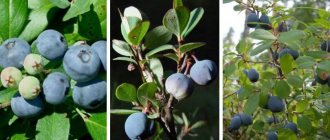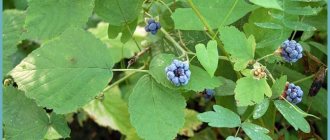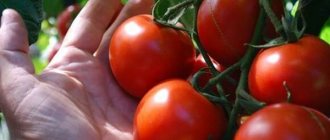Early varieties of white cabbage ripen in 70 - 105 days.
This means that the first harvest can be harvested in mid-June. Cabbage with early ripening dates is significantly different from medium and late varieties of cabbage. First of all, early cabbage cannot boast of taste, and here it loses. But in return, we get a more useful composition, which is beneficial for the human body. By the way
, early varieties, usually have medium-sized heads of cabbage with a loose structure. And therefore, they are poorly stored and transported. And yet, the vegetable can easily survive a temperature drop of -2 °C. It is worth noting that early cabbage is prone to cracking.
Early cabbage is mainly used fresh, and you can also cook soups and cabbage soup from it. It is not suitable for winter preparations, because after a short time the cabbage softens. Also, it is not suitable for sourdough, because it will not crunch. Further in the article, we will consider the best early varieties of cabbage. Go?
June
June cabbage is an old, time-tested variety. Which was bred by Soviet breeders in 1967. And after 4 years it was entered into the state register. Designed for cultivation in any region.
Description of the variety
:
June cabbage ripens in 90 - 110 days.
The leaf rosette variety is compact in size, up to 50 cm in diameter. The leaves of June cabbage are light green in color and are not large in size. The leaf blade has slightly wavy edges, and also a slight waxy coating is observed.
Heads of cabbage can grow on average up to 1.5 kg - 2.5 kg. At the same time, they are juicy, quite dense, tender, and their shape is flat-chested.
The benefits of cabbage
:
- Transportability. The heads of cabbage are quite dense, therefore, they are not afraid of mechanical stress.
- High yield. Collect up to 7 kg of cabbage from 1 sq. m plot.
- Good taste.
- Marketable condition. 97% of products are suitable for sale on the market.
Disadvantages of cabbage
:
- Early varieties of cabbage, such as June cabbage, do not tolerate low temperatures (even -2 ° C is detrimental for cabbage).
- Poor resistance to cracking.
- The variety is not resistant to clubroot and cabbage fly.
Surprise
An early ripening hybrid bred in Holland. The culture is well adapted to Russian climatic conditions. Sowing of seeds is carried out from February to April. The growing season takes 90-110 days. The plant is resistant to cold temperatures. Surprise gives a stable harvest - from 3 to 5 kg per square meter.
Related article:
What is the name of curly cabbage and how to grow it
Cossack F1
A Russian hybrid created by scientists from Moscow and Krasnodar.
Cabbage was included in the state register in 1996. The hybrid can be grown throughout Russia. Description of the hybrid
:
The leaf rosette is compact, up to 30 cm in height and up to 70 cm in diameter. The leaves are small with short petioles. Their color is dark green, the edges of the leaves are slightly wavy.
On average, heads of cabbage are within 1 kg. Their color is green, and in cross-section they are white with a yellowish tint. The head can grow up to 17 cm in diameter. The inner stalk can be up to 6 cm, but the outer stalk can be up to 10 cm.
Like any early cabbage, Kazachok F1 is intended for fresh consumption (in salads).
Pros of cabbage
:
- Strong immunity. Early cabbage varieties such as Kazachok F1 are resistant to fusarium and mucous bacteriosis. And it is conditionally resistant to clubroot and vascular bacteriosis.
- Frost resistance. Cabbage easily tolerates low temperatures.
- Unpretentiousness. Even poor soils can grow good cabbage.
- Taste qualities. Good taste is affected by the amount of sugar in the vegetable (4.2 g per 100 g).
- Friendly maturation.
- Precocity.
Cons of cabbage
:
- Heat resistance. Cabbage does not tolerate drought at all, so if you do not have the opportunity to always be in the garden, then it is better not to plant it (you need to water it). By the way
, in the southern regions cabbage is planted early so that it has time to ripen before the heat. - Cabbage does not tolerate shade.
Features of care
Plant care is an important point when growing cabbage. Early varieties often suffer from bursting. To avoid this, you need to follow certain recommendations.
- Watering
Cabbage loves water, but don’t overdo it, as this is what most often leads to cracking.
It is necessary to prevent the formation of a crust on the surface of the earth, and therefore immediately after watering it is worth carefully loosening the soil. The bush is watered with 2 liters of water during the dry period.
Watering cabbage in a greenhouse
- Top dressing
It is recommended to apply fertilizing exclusively together with watering, so as not to burn the cabbage roots.
The first introduction of fertilizers into the soil should be done after the seedlings have taken root. Feeding is carried out in liquid form. To do this, you need to dilute 2 g of ammonium nitrate in 2 liters of water.
- Loosening
Parel F1
Super early hybrid from the Netherlands.
Which was included in the state register of the Russian Federation in 1993. The hybrid is allowed to be grown almost throughout Russia. At the same time, it is grown both in household plots and in farms on an industrial scale. Hybrid characteristics
:
Super early hybrid that ripens in 90 days.
It has a small rosette of leaves, with small leaves of gray-green color. Also, a waxy coating is observed. When cut, you can observe white and yellowish flesh, which is medium in density. The taste is pleasant. The inner stalk is short.
On average, pumpkins weigh 0.8 kg - 1.5 kg. Parel F1 is recommended to be consumed only fresh.
The benefits of cabbage
:
- High yield. Early cabbage varieties such as Parel F1 can have a yield of up to 4.5 kg per 1 sq. m plot.
- Transportability. Here, thanks to the dense hummocks, cabbage can be transported.
- Precocity.
- Harmonious ripening of the crop.
- Excellent taste. Dry matter in cabbage is up to 7%. Also, it contains a lot of vitamin C, therefore, dishes for children are prepared from it.
- Resistant to cracking.
Disadvantages of cabbage
:
- You can't ferment.
- Long-term storage is not possible.
Ditmarskaya Early
The variety was bred in Germany and has not yet been included in the state register, but this does not prevent cabbage from conquering the vast expanses of Russia. Important
. Cabbage is a variety, so if you have the knowledge, you can get your own seeds.
Descriptions of the variety
:
Such early varieties of cabbage as Ditmarskaya Rannyaya have a ripening period of 105 - 110 days.
The leaf rosette has compact dimensions. The leaves are bright green and their edges are wavy. At the same time, the leaves are raised low above the ground.
Cabbage heads reach up to 1.5 kg - 2 kg. When cut, they have milky flesh, which corresponds to the variety. Both stalks, both internal and external, are short. By the way
, Early Ditmar cabbage is very similar to Chinese cabbage.
Pros of cabbage
:
- Stress resistance. Tolerates temperature changes and sudden drops well.
- Friendly maturation.
- Great taste. The cabbage is juicy and crispy.
- Resistance to fusarium. And also to some other diseases.
- Transportability. The heads of cabbage are dense, so they are not afraid of mechanical stress.
- Good presentation. Heads of cabbage have a round, leveled shape.
Cons of cabbage
:
- The need for fertilizing and watering.
- When humidity levels increase, cracking is possible.
Oracle
An early ripening hybrid, the ripening period of which is 55 days. It is recommended to grow Oracle under covering material. The fruits are round and dense. The leaves are powerful, with a waxy coating.
Advantages:
- simultaneous maturation of the heads;
- resistance to lack of moisture and temperature fluctuations;
- beautiful presentation;
- high resistance to fusarium;
- good transportability.
Related article:
Growing Chinese cabbage
Golden hectare
An ancient variety that was bred by Soviet breeders in 1938, and 5 years later Golden Hectare cabbage was added to the state register of the Russian Federation (1943). The variety is still in demand among Russian gardeners. Cabbage is allowed to be grown throughout Russia (in 10 regions). By the way
, this is a variety, which means you can get your own seeds from it.
Characteristics of the variety
:
Early varieties of cabbage, such as Golden Hectare, are considered early; here the variety ripens in 100 days. And here, 60 days is after planting the seedlings, while the seedlings are 35 days old.
The leaf rosette has compact dimensions. The leaves are small and round or oval in shape. The petiole is short. The color is grey-green. The edges of the leaves are smooth, but sometimes slightly wavy. The inner stalk is short, but thick. Important
. The root of the Golden Hectare is of a rod type, which goes 40 cm deep.
Heads of cabbage grow up to 1.5 kg - 3 kg, although they can grow up to 4 kg. Density is average. Maturation is friendly. By the way
, cabbage is considered a dietary product because it contains a lot of vitamin C.
The benefits of cabbage
:
- High yield. Golden Hectare is considered a high-yielding variety, where from 1 sq. m area, 5 - 6 kg of products are removed. By the way
, not many early varieties can boast of such results. - Strong immunity. But manufacturers warn that cabbage is not at all protected from clubroot.
- Cracking is not typical. Although if there is an excess of moisture, the heads of cabbage still crack.
- Resistance to adverse conditions. Here, cabbage can withstand both frost and drought. Note that this is all short-term.
- Taste qualities. It contains a lot of ascorbic acid.
- The purpose is universal. This distinguishes this variety from many early ripening varieties. Cabbage can be stewed, and some gardeners even ferment it.
Disadvantages of cabbage
:
- The Golden Hectare is completely unprotected from clubroot. Although, he has good immunity.
- Short term storage. Here, everything is like all varieties of early cabbage.
The best varieties of cabbage for pickling and pickling
When fermenting and pickling cabbage, the dietary properties of the vegetable and the vitamins contained in the cabbage are well preserved. But not every variety of cabbage is suitable for pickling or pickling. Most mid-season varieties of white cabbage and some mid-late varieties are suitable for these purposes.
We present to you the best varieties of mid-season and mid-late white cabbage, cultivated in the conditions of the Urals and Siberia, suitable for pickling and pickling (you can find a description of the varieties above):
- SB 3 F1
- Gourmand F1
- Ankoma F1
- Pobeda F1
- Tobia F1
- Pudovaya F1
- Rinda F1
- Cyclops F1
- Favorite F1
- Thomas F1
- Aggressor F1
- Landini F1
- Pructor F1
- Menzania F1
- Swan F1
- Dobrovodskaya
- Semko Yubileiny 217 F1
Copenhagen Market
Copenhagen Market cabbage is considered a mid-early cabbage, and it ripens in 115 days.
People love it for its wonderful taste, which really comes out in salads. Description of the variety
:
The plant has a compact size. The leaves are medium-sized, gray-green in color. Heads of cabbage grow up to 2 kg - 2.5 kg. When cut, they have white flesh, which is dense in consistency, tastes pleasant and juicy. By the way
, cabbage leaves are not hard, therefore, it is especially good in salads. And you can even salt it.
Pros of cabbage
:
- Great taste. The cabbage is tender and juicy. At the same time, it contains many vitamins.
- Early ripening. Although here, they are not very early, but it all depends on the growing conditions.
- Resistant to cracking.
- Marketable condition.
- Can easily tolerate small short-term frosts.
- High yield. Here, they collect 3.5 kg - 4.5 kg per 1 sq. m plot.
Cons of cabbage
:
- Short term storage.
Characteristics and types of white vegetables
Early ripening cabbage has a very short ripening time - 90-110 days after planting the seeds, young heads of cabbage can already be cut. Most varieties will ripen in the first half of July. A feature of early varieties is the looser structure of the head of cabbage: the leaves of such cabbage are tender and juicy, and the core is dense and hard.
Crispy fresh cabbage is good for a summer salad, rich in vitamins and minerals. But the fragile watery leaves cannot be pickled or pickled; the heads of such a vegetable do not last long and quickly lose their attractive appearance.
Important! Reviews from gardeners also indicate that early-ripening varieties are less resistant to various diseases and pests.
There are not as many varieties of early cabbage as varieties with middle and late ripening periods (after all, these crops are more popular in the middle zone). The most popular names of early ripening varieties and hybrids in Russia will be given below.
Rinda F1
The early hybrid is intended for cultivation in southern regions and in temperate climate zones. Heads of cabbage grow to medium size. Rinda's leaves are large, spreading, and colored in a light green shade. The taste of this crop is very good.
Unlike most other early varieties, this cabbage can be stored for up to four months. But for this it is necessary to create suitable conditions: a temperature of +8 degrees and constant moderate humidity.
In regions with very warm climates, Rinda is grown twice a year, repeating the sowing of seeds immediately after the first harvest. Gardeners love this variety for its unpretentiousness and resistance to cool spring temperatures.
Tobia F1
This early hybrid is characterized by very high yields - for those who grow vegetables for sale, a better variety simply cannot be found! The cabbage heads are large and approximately the same - the weight of each head is about 3.5 kg.
Tobia is not prone to over-ripening, its heads do not crack, and its leaves do not lose their crispness and taste. The taste characteristics of the hybrid are good. Tobia's heads are smooth, leveled, and shiny.
The structure of the head is dense, the inside of the cabbage has a yellowish-white tint, and the outside of the head is bright green. Hybrid cabbage can be stored, but not for long - about two months.
Cossack F1
An ultra-early variety that produces the first harvests within 40-45 days after planting the seedlings in the ground. This cabbage is very tasty, has a creamy white interior and a dense head structure. The vegetable heads are colored light green and are of medium size - approximately 1500 grams. The variety is resistant to cracking and overripening.
It is recommended to grow Cossack in open ground or under temporary film covers. Cabbage tolerates low temperatures well and practically does not get sick.
Taurus F1
Full ripening of this hybrid occurs on the 95-100th day after sowing the seeds for seedlings. Taurus heads can be cut as early as mid-July.
The hybrid early variety is considered one of the most productive. It's all about the size of the heads of cabbage - their weight often reaches five to six kilograms. This cabbage has several other significant advantages: the variety is very resistant to drought and is immune to most “cabbage” diseases.
Attention! White cabbage of early varieties can be grown in open ground only in the southern regions of the country; only some resistant hybrids are zoned for the central regions. In northern Russia, early-ripening vegetables are planted only in greenhouses.
June
In Russia it is difficult to find a dacha where June cabbage has not been grown at least once. This early variety is very popular among domestic gardeners, because it is zoned specifically for temperate climates.
The taste of the early culture is very good: the structure of the head of cabbage is dense, the leaves are tender and juicy, the taste is soft and pleasant. Juneteenth cabbage is great in salads and appetizers, and its delicate flavor pairs well with other vegetables in stews.
The heads of this vegetable variety are medium - they weigh 2-3 kilograms, which allows the vegetable to be used sparingly in fresh salads. The ripening of the heads, as you might guess from the name of the variety, occurs in June.
The variety is suitable for growing in open ground and under temporary film shelters.
Express F1
Super early cabbage, which appeared quite recently, but has already won the love of domestic gardeners and summer residents. From the moment the seedlings are planted in the ground until the vegetable fully ripens, only 40-45 days pass (the total growing season is about 90 days).
The variety is high-yielding and has excellent taste characteristics. The heads of cabbage are round, light green, and light in weight (on average, 1300 grams). Once harvested, cabbage can be stored for up to four months if suitable conditions are provided.
Advice! Experienced gardeners recommend growing early varieties of cabbage in high, warm beds. The structure of the bed, in which compost serves as the bottom layer, ensures heating of the top layer of soil and the root system of the seedlings. All this allows us to achieve 100% yield of early-ripening cabbage even in the central regions.
Polar region F1
There are also the best varieties of early cabbage, specially designed for growing in the most difficult climatic conditions. An excellent example of such cabbage is the Arctic hybrid.
The ripening period is very short - the harvest can be harvested within 45 days after planting the seedlings in the soil. The hybrid tolerates low temperatures well, but loves light and moisture - this must be taken into account.
The leaf rosettes of the crop are compact - the diameter is only 50 cm. The heads are also medium-sized - weighing 1-1.6 kg. The heads of cabbage are round, beautiful, and not prone to cracking (shown in the photo).
Surprise F1
Dutch hybrid with very early ripening time - 95-100 days from the moment of sowing the seeds. The heads of cabbage are round, leveled, and light green in color.
The tasting rating of the variety is 4.5 points. Cabbage is very tasty fresh. When cut, the head of cabbage is greenish-white in color and dense. The average weight of the heads is 1300 grams. The variety is resistant to cracking.
Nozomi "R. ABOUT."
The earliest, or one of the earliest, is Nozomi cabbage. After planting the seedlings in the ground, only 43-45 days pass until full maturity. The hybrid variety is very productive.
The heads of cabbage resemble a ball, round and even. The average weight of cabbage is 2 kg. Its structure is dense, the heads do not crack, and they tolerate transportation and storage well.
Gardeners love this variety for its amazing durability: the seedlings are not afraid of return frosts, tolerate waterlogging of the soil well, do not suffer from fungal and putrefactive infections, and are immune to blackleg.
Zolotovorotskaya
Another early variety that allows harvesting already on the 55th day after planting the seedlings.
Cabbage produces compact rosettes, its heads are elastic, round, weighing about two kilograms. The heads are painted a soft green color and have an excellent taste. The variety is resistant to cracking and blooming.
Zolotovorotskaya is used mainly for preparing summer salads.
Zantorino F1
The fruit of the labor of Dutch breeders is the early Zantorino variety. Full ripening occurs 95-100 days after sowing the seeds in the soil.
The heads of cabbage are spherical, even and smooth, painted in a light green shade. The structure of the cabbage is of medium density, the heads of cabbage do not crack. Heads of cabbage grow up to 1.7-2.1 kg and have an excellent taste.
The hybrid is intended for fresh consumption. They begin to cut off the heads from the last days of June.
Parel F1
The Dutch created a high-yielding hybrid with very early ripening. Only 52 days pass from the moment the seedlings are planted, and the cabbage can be cut for fresh consumption.
The heads of cabbage are medium-sized (up to one and a half kilograms), colored light green, greenish-white when cut. The structure of the heads is dense, they do not crack, and tolerate transportation well.
Parel's taste is very good - tasters rate it five points. The culture of this variety is recommended for cultivation in open ground and in greenhouses.
Attention! Early varieties of cabbage require closer attention from the gardener. This crop needs to be watered regularly (1-2 times a week), fertilized several times a season (using liquid solutions), hill up the stalks and weed the beds, and spray the leaves with preventive agents.
Golden Hectare
Very productive early cabbage, ripening 110 days after planting. The heads ripen together and weigh about three kilograms. The taste of the variety is good.
The early-ripening crop loves warmth, light and moisture, and can tolerate low temperatures and light frosts.
Dita
An early ripening variety, it enters the technical maturity phase by the 100th day after planting. The heads of cabbage grow on a high stem, have a round shape and compact size.
The average weight of Dita's heads is only one kilogram. The heads of cabbage are resistant to cracking, transport well, and can be stored for a couple of months.
Advice! In the south, the Dita variety can be grown in open ground. In colder regions, it is better to plant this early cabbage in a greenhouse or greenhouse.
Ditmarskaya early
Early variety - about 65 days from the moment the seedlings are transferred to the ground. The heads of cabbage are round, even, their average weight is 1.5-2 kg. When overripe, cabbage can crack, so you need to harvest Ditmarskaya in a timely manner. The vegetable crop is intended for preparing fresh salads; it is often grown for sale in late June - early July.
Dumas F1
Dumas cabbage F1 is a hybrid that ripens in 90 - 100 days.
The plant is compact in size. With leaves of medium size and slightly wavy edges. Their color can be gray-green. They are smooth to the touch.
Heads of cabbage grow on average to 0.8 kg - 1.5 kg.
The benefits of cabbage
:
- The main advantage of cabbage is the ability to grow in dense plantings.
- Precocity. Early cabbage varieties such as Dumas F1 are considered ultra-early ripening varieties.
- Resistant to cracking. Here, even under the most unfavorable conditions, the cabbage does not crack.
- Excellent presentation. The fruits are compact and aligned.
- Cabbage can be transported over long distances.
- Good taste. Taste with notes of sweetness.
- Resistance to adverse weather conditions (temperature changes, heat, rain).
Disadvantages of cabbage
:
- Poor keeping quality.
Kevin
An early ripening variety bred in Switzerland. Grows best in clay soil. The growing season lasts 51-53 days. Neat heads of cabbage are smooth and round. The culture is cold-resistant and tolerates frost well. Feeding and high humidity are important for her. Kevin is resistant to cracking and shooting. Able to maintain its presentation for a long time.
Related article:
Cauliflower - the best varieties for open ground, cultivation and care
Transfer F1
Transfer F1 is a hybrid that was jointly created by scientists from Moscow and Krasnodar.
And in 1993, the hybrid was included in the state register of the Russian Federation. Cabbage has been recommended for cultivation in almost all regions of Russia. Also, the hybrid can be grown in country houses and on farms for sale on the market. Description of the hybrid
:
Early cabbage varieties such as Transfer F1 are considered early ripening, and here the cabbage ripens in 100 days. By the way
, this is a hybrid, so you won’t be able to get your own seeds from it.
Cabbage has a compact leaf rosette. The color of the leaf plate can be light green. The leaves are round in shape, slightly wavy at the edges. Also, there is a waxy coating on the leaves.
The heads of cabbage are small, up to 1.5 kg. They have a round shape and a greenish-whitish color. When cut, you can see white pulp of medium density. The inner stalk is very short.
Pros of cabbage
:
- Good yield. And this is 3 kg - 4 kg per 1 sq. m plot.
- Marketable condition. Of the total harvest, 94% can be sold on the market.
- Friendly maturation. This will be especially useful on farms where cabbage needs to be sold on the market.
- The purpose is universal. Cabbage can be consumed fresh and for processing. Except pickling and pickling.
- Great taste.
- Disease resistance.
- Unpretentiousness.
Cons of cabbage
:
- Not suitable for pickling and pickling.
- Short shelf life.
Varieties of early white cabbage for different regions
Early ripening varieties and hybrids of white cabbage differ in their origin and consumer qualities. As a result of field tests, recommendations were developed on the optimal assortment for specific Russian regions.
For the Middle Band
- Orient Express F1
- Solo F1
- Sprint F1
- Transfer F1
- Express F1
For the Moscow region
- Garden head
- Zarya MS
- Malachite F1
- Orion Hunter F1
- First love F1
For Siberia and the Urals
- Explosion F1
- Dove
- Number one polar K 206
- Sugar Lightning F1
- Siberian pyramid
Malachite F1
This early-ripening hybrid was jointly developed by scientists from Moscow and Krasnodar.
And in 1993 it was included in the state register of the Russian Federation. The hybrid was allowed to be grown almost throughout the entire territory of Russia. At the same time, people can grow cabbage in their dachas, on farms on an industrial scale. Hybrid characteristics
:
Malachite F1 cabbage can be considered early ripening; its ripening period averages 90 - 135 days. Important
. Differences in ripening times most often occur due to the fact that manufacturers on packages begin to count the period from planting seedlings into the ground, or from cabbage sprouting (full growing season).
The leaf rosette of cabbage has a compact size. And this is 25 cm - 30 cm in height, while in diameter it can be 50 cm - 60 cm. The leaves are small, round, which are colored green with a grayish tint. Their edges are slightly wavy. Also, there is an intense waxy coating on the leaves.
On average, the heads of cabbage weigh 1.3 kg - 1.5 kg, while their diameter reaches 15 cm - 17 cm. The outside of the heads of cabbage is colored green, and when cut, they are white with yellowish color. The inner stalk is on average 8 cm, but the outer stalk usually does not exceed 6 cm.
The benefits of cabbage
:
- Good yield. Such early varieties of cabbage as Malachite F1 have a yield of up to 7 kg per 1 sq. m plot.
- Friendly maturation. This is especially appreciated when growing cabbage on an industrial scale.
- The heads of cabbage do not crack.
- Great taste. Cabbage has a sweetish taste. Also, it contains a lot of carotene and ascorbic acid. And yet, it has a few veins, which in turn are not hard.
Disadvantages of cabbage
:
- Weak immunity. Here, cabbage can still resist blackleg, fusarium, and bacteriosis. But she is completely defenseless against clubroot.
Seedling growing method
In order to get cabbage as early as possible, it is best to use the seedling growing method. In this way, you will protect the plant at a young age from pests and diseases and ensure the formation of full-fledged heads of cabbage with a long growing season.
Preparing seeds for sowing
Seeds sold, as a rule, are already sorted and disinfected and do not require additional processing. If you bought seeds of questionable quality, or use your own material, then it is necessary to carry out pre-sowing preparation.
Against clubroot and other fungal diseases, the seeds are placed for 20 minutes in warm water heated to 50 degrees. The water temperature is maintained at the same level. Then the seeds are placed in cool water for 3-5 minutes and dried thoroughly.
During the disinfection process, floating and small seeds are removed.
There are two ways to grow seedlings: potted and potless. In both cases, sowing seeds can be done with or without further picking.
Pot method
Recently, potted seedlings have been increasingly used. Its advantage is good survival rate, because the root system is kept intact before planting.
If you want to grow early cabbage seedlings without picking, then sowing should be done from late February to mid-March. Preparing the soil for seedlings includes mixing soil and humus in equal parts and adding mineral fertilizers: 30 g of superphosphate, 15 g of potassium nitrate, 10 g of ammonium nitrate per bucket of the mixture. Or any complex fertilizer for cabbage.
Young plants do not tolerate high salt concentrations well. Therefore, only half the dose of fertilizer is added to seedling mixtures based on humus and turf soil. If there are no signs of starvation, seedlings may not be fed.
As a soil for seedlings, you can use transitional or lowland peat with the addition of sand and sawdust. In the absence of microfertilizers, ash is added to the soil mixture at the rate of 2 cups per bucket.
When the soil for seedlings is prepared, you can start sowing:
- Sow 2-3 cabbage seeds into each container at a depth of 1.5-2 cm in order to select the most successful seedling in the future. After sowing, water the soil generously with water at room temperature. For faster germination of seeds, the pots can be covered with film.
- Maintain the seeded material at a temperature of 25 degrees until seedlings emerge. Then lower the temperature to 8-10 degrees to avoid stretching the seedlings. With the appearance of the first true leaf, raise the temperature to 15-17 degrees during the day and to 10 degrees at night.
- Lowering the temperature at night is necessary so that the seedlings do not grow pampered. Such seedlings do not take root well in the soil. Good seedlings ready for planting in the ground should be stocky and have 4-5 true leaves.
- Keep the soil moderately moist during the growing process to prevent the plant from becoming infected with blackleg. If you discover this disease, ventilate the room and sprinkle the soil with the plant with dry sand. To protect against diseases, add potassium permanganate (3 g per 10 liters of water) to irrigation water.
Potless method
When growing in large volumes or when there is not enough space, use a potless method of growing seedlings. To do this, place the prepared wet mixture in an even layer of 5-6 cm in the boxes and make grooves at a distance of 3-4 cm from one another.
In the phase of 1-2 true leaves, pick the seedlings into pots measuring 6 by 6 cm, or thin out the plants at a distance of 5-6 cm without picking. In potless seedlings, only 10% of the volume of the root system is retained during transplantation.
Potless method with preservation of the root system
There is another way to grow seedlings, which does not involve the use of containers, but it keeps the root system as intact as possible. With this method, pots are formed from well-moistened soil mixture.
To prevent the soil from crumbling when watering, mullein is added to it as a binding material. Its consumption should be no more than 0.5 liters per 1 bucket of mixture. Be careful when preparing this composition, because an excess of mullein will make the soil too dense, which will adversely affect the development of seedlings.
Place the wet mixture in an even layer of 5-6 cm in boxes or directly on the covered soil in a greenhouse, compact it slightly, and then cut along the entire height along and across, forming cubes 6 by 6 cm.
Gribovskaya 147
Cabbage Gribovskaya 147 was bred in 1940 by Soviet scientists.
It is based on German hybrids. As a result, the result was a hybrid adapted to any climatic conditions. Gribovskaya cabbage 147 can be grown almost everywhere in Russia, except for the northernmost regions. Description of the hybrid
:
An early ripening cabbage hybrid that ripens within 100 days from germination. And if you measure from the time of planting the seedlings in a permanent place, then it turns out 60 days (+ age of the seedlings 35 days).
The leaf rosette is compact, with whole light green leaves covered with a waxy coating. The diameter of the outlet can be up to 60 cm.
Heads of cabbage are round in shape and weigh up to 3 kg. Their color is light green. When cut, you can see white pulp with a pleasant taste.
Pros of cabbage
:
- Resistance to adverse weather conditions. Cabbage tolerates high humidity and drought particularly well.
- Good taste. Here, sugar contains 5%, dry matter 8%, a lot of vitamins, especially vitamin C and carotene.
- High yield. From 1 sq. m area, up to 7 kg of products are removed.
- Versatility in use. It is eaten both fresh and stewed. Also, cabbage soup, borscht, cabbage rolls and stews are prepared from cabbage.
- Simultaneous maturation. Such early varieties of cabbage as Gribovskaya 147 ripen together. Useful for farms.
- Precocity.
- Excellent presentation. The heads of cabbage are of medium density, and they are leveled.
- Transportability.
Cons of cabbage
:
- Weak resistance to vascular bacteriosis and clubroot.
Express F1
An early hybrid that was bred in Ukraine, and already in 2003 it was included in the state register of the Russian Federation.
The hybrid in Russia can be grown in Siberia, the Ural, Central, Volga and North Caucasus regions. Description of the hybrid
:
The full growing season of cabbage is only 60 days. This is under favorable conditions, but if this is not the case, then the period may be 95 days.
The leaf rosette is compact, with light green leaves with a faint waxy coating. The head of cabbage is spherical with medium density, which weighs on average 1 kg. When cut, the head of cabbage has whitish flesh. The stalks, both internal and external, are short.
The benefits of cabbage
:
- Early ripening.
- The heads of cabbage ripen at the same time. It is important when cabbage is grown on an industrial scale for sale on the market.
- Excellent presentation. Here, 94% of the harvest can be sold on the market.
- Great taste. Early cabbage varieties such as Express F1 contain up to 5% sugar.
- Good yield. This is up to 4 kg per 1 sq. m plot.
Disadvantages of cabbage
:
- In hot weather, the heads of cabbage may crack due to overheating.
- At low temperatures and in low light, instead of one, 2 small forks are formed on the cabbage.
How to get a good harvest of early cabbage
It is not enough to simply sow the seeds of early white cabbage in open ground. There are several secrets, knowing which you will be guaranteed an excellent harvest.
It is worth choosing cabbage according to climate conditions and soil quality
- Let's start by buying seeds. They should in no case be purchased from hand, but in specialized stores. Buying secondhand is fraught with the fact that you may get a bad harvest, or what will grow in your garden beds is not at all what you expected.
- Bags of high-quality seeds must contain detailed information: company name, batch number, what region they are intended for (the variety must be suitable for the climatic conditions of your region), ripening dates, shelf life (usually 4-5 years). The latter is very important.
- If the expiration date is not indicated, then it is better to refrain from purchasing. You should not buy expired seeds. Today, seeds can be ordered on the Internet, which will make it possible to quickly find what you need and save time and money if you make “joint purchases” on wholesale sites.
- In order not to find yourself without early cabbage, buy little by little different varieties of seeds from different manufacturers: if some do not sprout or turn out to be low-yielding, then others will not let you down.
Tip #2. Early cabbage varieties should be planted in early March and finished in May. The soil should be light, moderately moist and loose.
Miracle Ultra Early F1
Early cabbage varieties such as Miracle Ultra Early F1 ripen within 60 - 70 days.
The plant is compact in size, where it can be 40 cm - 50 cm in height, and it spreads over a diameter of 40 cm - 45 cm. The leaves are small green. The edges of the leaves are slightly wavy. Also, there is a waxy coating.
Heads of cabbage grow up to 1.5 kg - 2 kg. They have a round shape and a rich green color. The density of the tussocks is average. When cut, cabbage is white, but sometimes it is creamy. Both stalks are short.
Pros of cabbage
:
- Great taste. Everything in cabbage is balanced, and there are no sharp or bitter undertones. Cabbage is suitable for fresh consumption, and it is also good in spring vitamin soups and borscht.
- Terms of ripening. Very early.
- Productivity. Cabbage harvest from 1 sq. m plot is removed at 6 kg - 8 kg, and this is if for 1 sq. m there are 4 plants.
- Cabbage is resistant to many diseases.
- Resistance to bad weather conditions. Cabbage easily tolerates temperature changes, as well as short-term frosts.
- Marketable condition. Good products can be at least 92%.
Cons of cabbage
:
- Cabbage does not tolerate a lack of moisture. You need to water regularly.
- Long-term storage is not possible.
Akira F1
The Akira F1 hybrid is considered super early, and ripening here occurs within 50 - 52 days.
Used for forcing super early harvests in greenhouses or greenhouses. Although, cultivation in open ground is also allowed. Heads of cabbage grow up to 1 kg - 2 kg. They are spherical in shape. Their color is bright green. The structure of the tussocks is dense. Both stalks are small.
The benefits of cabbage
:
- Good yield. This is 7 kg - 8 kg of cabbage per 1 sq. m plot.
- Precocity.
- Marketability.
- Transportability.
- Great taste. Classic, without sharpness or bitterness.
- Not prone to cracking.
- Both stalks are small.
Disadvantages of cabbage
:
- Regular watering is important for cabbage.
Ethma
Dutch cabbage, which is grown in open ground or greenhouses. The plant needs good lighting. Under proper conditions, up to 10 kg of product is obtained per square meter. The hybrid ripens early - 45-50 days after planting the seedlings. Let's allow harvesting using mechanized methods. Etma has excellent taste characteristics. The pulp is juicy and tender, without hard veins.
Related article:
Agricultural technology for growing broccoli
The culture has good immunity to internal necrosis and fusarium.
